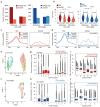This is a preprint.
Epigenomic, transcriptomic and proteomic characterizations of reference samples
- PMID: 39314461
- PMCID: PMC11419083
- DOI: 10.1101/2024.09.09.612110
Epigenomic, transcriptomic and proteomic characterizations of reference samples
Abstract
A variety of newly developed next-generation sequencing technologies are making their way rapidly into the research and clinical applications, for which accuracy and cross-lab reproducibility are critical, and reference standards are much needed. Our previous multicenter studies under the SEQC-2 umbrella using a breast cancer cell line with paired B-cell line have produced a large amount of different genomic data including whole genome sequencing (Illumina, PacBio, Nanopore), HiC, and scRNA-seq with detailed analyses on somatic mutations, single-nucleotide variations (SNVs), and structural variations (SVs). However, there is still a lack of well-characterized reference materials which include epigenomic and proteomic data. Here we further performed ATAC-seq, Methyl-seq, RNA-seq, and proteomic analyses and provided a comprehensive catalog of the epigenomic landscape, which overlapped with the transcriptomes and proteomes for the two cell lines. We identified >7,700 peptide isoforms, where the majority (95%) of the genes had a single peptide isoform. Protein expression of the transcripts overlapping CGIs were much higher than the protein expression of the non-CGI transcripts in both cell lines. We further demonstrated the evidence that certain SNVs were incorporated into mutated peptides. We observed that open chromatin regions had low methylation which were largely regulated by CG density, where CG-rich regions had more accessible chromatin, low methylation, and higher gene and protein expression. The CG-poor regions had higher repressive epigenetic regulations (higher DNA methylation) and less open chromatin, resulting in a cell line specific methylation and gene expression patterns. Our studies provide well-defined reference materials consisting of two cell lines with genomic, epigenomic, transcriptomic, scRNA-seq and proteomic characterizations which can serve as standards for validating and benchmarking not only on various omics assays, but also on bioinformatics methods. It will be a valuable resource for both research and clinical communities.
Conflict of interest statement
Competing interests Andrew Farmer is an employee of Takara Bio USA, Inc., and Wendell Jones is an employee of Q2 Solution company. All other authors claim there are no conflicts of interest. The views presented in this article do not necessarily reflect the current or future opinion or policy of the US Food and Drug Administration. Any mention of commercial products is for clarification and not intended as an endorsement.
Figures







References
-
- Gazdar A.F. et al. Characterization of paired tumor and non-tumor cell lines established from patients with breast cancer. Int J Cancer 78, 766–74 (1998). - PubMed
Publication types
Grants and funding
LinkOut - more resources
Full Text Sources
Molecular Biology Databases
Miscellaneous
